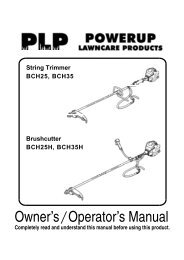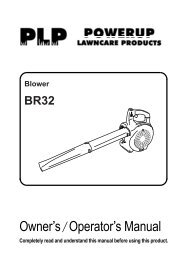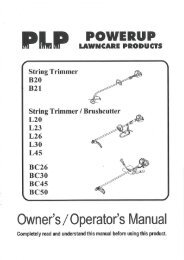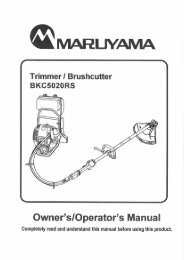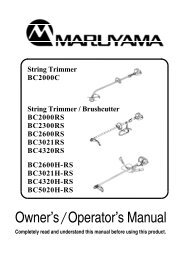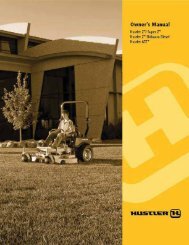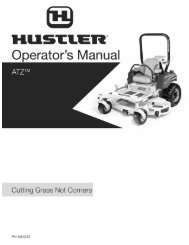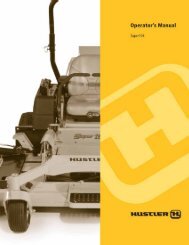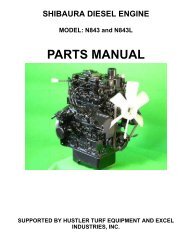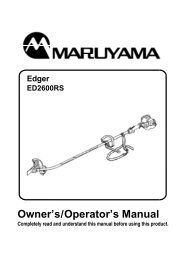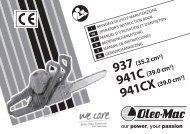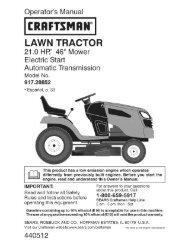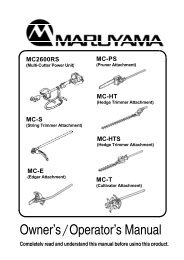Download the Fastrack Super Duty Owner's Manual 48/54/60
Download the Fastrack Super Duty Owner's Manual 48/54/60
Download the Fastrack Super Duty Owner's Manual 48/54/60
You also want an ePaper? Increase the reach of your titles
YUMPU automatically turns print PDFs into web optimized ePapers that Google loves.
solenoids, electronic controls, vacuum control diaphragms,<br />
purge valves, liquid/vapor separator and o<strong>the</strong>r associated<br />
components.<br />
Modifying or Tampering with <strong>the</strong> evaporative emissions<br />
control system or <strong>the</strong> fuel system is prohibited. Federal law<br />
and California State law prohibit <strong>the</strong> following acts or <strong>the</strong><br />
causing <strong>the</strong>reof:<br />
1. The removal or rendering inoperative by any person o<strong>the</strong>r<br />
than for purposes of maintenance, repair, replacement, of<br />
any device or element of design incorporated into any<br />
equipment for <strong>the</strong> purposes of emissions control prior to<br />
or after its sales or delivery to <strong>the</strong> ultimate purchaser or<br />
while it is in use, or<br />
2. The use of <strong>the</strong> equipment after such device or element of<br />
design has been removed or rendered inoperative by any<br />
person.<br />
WARNING<br />
Use of replacement parts not equivalent to <strong>the</strong> original<br />
parts may result in system failure and pose a safety hazard.<br />
DANGER<br />
To avoid personal injury or property damage, use<br />
extreme care in handling fuel. Fuel is extremely flammable<br />
and <strong>the</strong> vapors are explosive.<br />
WARNING<br />
Observe usual fuel handling precautions<br />
• Do not smoke while refueling. Extinguish all cigarettes,<br />
cigars, pipes and o<strong>the</strong>r sources of ignition.<br />
• Do not remove fuel cap or fill tank with engine<br />
running or while engine is hot. Clean up any fuel<br />
spills.<br />
• If fuel is spilled, do not attempt to start <strong>the</strong> engine<br />
but move <strong>the</strong> machine away from <strong>the</strong> area of spillage<br />
and avoid creating any source of ignition until<br />
fuel vapors have dissipated.<br />
• Allow engine to cool before storing machine inside<br />
a building.<br />
• Keep fuel away from open flame or spark and store<br />
machine away from open flame or spark or pilot<br />
light such as on a water heater or appliances.<br />
• Use extreme care when handling gasoline and o<strong>the</strong>r<br />
fuels which are extremely flammable and vapors<br />
are explosive. A fire or explosion from fuel can<br />
burn you and o<strong>the</strong>rs and can damage property.<br />
• Refuel outdoors. Never refuel or drain <strong>the</strong> fuel from<br />
<strong>the</strong> machine indoors.<br />
• Never attempt to start <strong>the</strong> engine when <strong>the</strong>re is a<br />
strong odor of gasoline fumes present. Locate and<br />
correct <strong>the</strong> cause.<br />
• Store fuel in an approved container and keep it out<br />
of <strong>the</strong> reach of children. Never buy more than a 30<br />
day supply of fuel.<br />
• Do not fill fuel containers inside a vehicle or on a<br />
truck or trailer bed with interior carpets or plastic<br />
truck bed liners. Always place fuel containers on<br />
<strong>the</strong> ground away from your vehicle before filling.<br />
• When practical, remove gas powered equipment<br />
from <strong>the</strong> truck or trailer and refuel <strong>the</strong> equipment<br />
with its wheels on <strong>the</strong> ground. If this is not possible,<br />
<strong>the</strong>n refuel such equipment on <strong>the</strong> truck or trailer<br />
using a portable container and not a fuel dispenser<br />
nozzle. If a fuel dispenser nozzle must be used,<br />
keep <strong>the</strong> nozzle in contact with <strong>the</strong> rim of <strong>the</strong> fuel<br />
tank or container opening at all times until fueling is<br />
complete. Do not use a nozzle lock-open device.<br />
• Never use gasoline for cleaning parts.<br />
• Read and observe safety precautions elsewhere in<br />
this manual.<br />
WARNING<br />
• Gasoline is harmful or fatal if swallowed.<br />
• Long-term exposure to vapors can cause serious<br />
injury and illness.<br />
• Avoid prolonged breathing of vapors.<br />
• Keep face away from nozzle and gas tank or fuel<br />
container opening.<br />
• Keep gas away from eyes and skin.<br />
• If fuel is spilled on clothing, change clothing immediately.<br />
The fuel tanks are located in <strong>the</strong> mower’s fenders.<br />
Remove <strong>the</strong> fuel cap slowly.<br />
When threading <strong>the</strong> fuel cap onto <strong>the</strong> filler neck, tighten <strong>the</strong><br />
cap until it begins to click, <strong>the</strong>n, continue to turn it until at least<br />
three clicks are heard.<br />
IMPORTANT: Do not overfill <strong>the</strong> fuel tanks. The fuel tanks<br />
should be filled no higher than <strong>the</strong> bottom of <strong>the</strong> fill neck.<br />
The fuel system is designed to leave room for <strong>the</strong> fuel to expand<br />
with fuel temperature changes.<br />
WARNING<br />
Overfilling fuel tanks may cause <strong>the</strong> following:<br />
• Engine damage<br />
• Fire hazard!<br />
Use regular unleaded gasoline with an octane rating of 87 or<br />
higher. Maximum of 10% ethanol (E10) in fuel. Fuels with<br />
greater than 10% ethanol, (such as E15, E20 and E85) voids<br />
warranty. Fuels with greater than 10% ethanol are not approved<br />
for use and such illegal use could cause equipment failure and<br />
pose a fire hazard. Refer to <strong>the</strong> engine owner’s manual for fuel<br />
REV E 4-4 <strong>60</strong>2901




